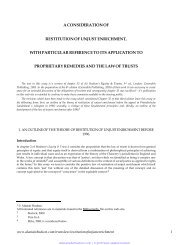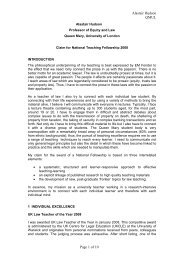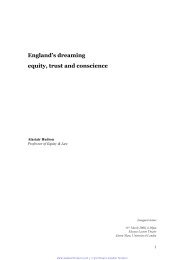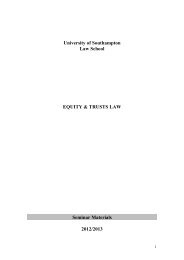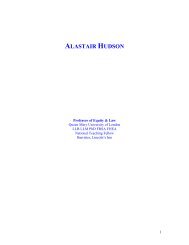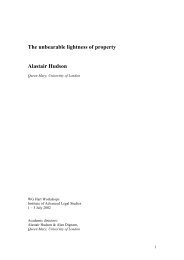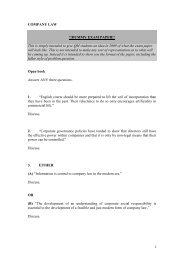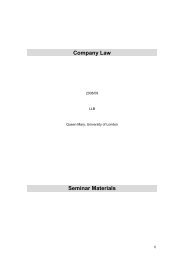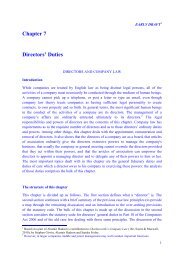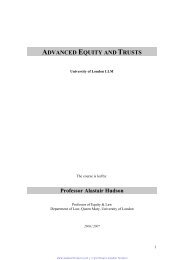Soton Equity and Trusts - alastairhudson.com
Soton Equity and Trusts - alastairhudson.com
Soton Equity and Trusts - alastairhudson.com
You also want an ePaper? Increase the reach of your titles
YUMPU automatically turns print PDFs into web optimized ePapers that Google loves.
(c)<br />
The nature of the constructive trust<br />
CMS Dolphin Ltd v. Simonet [2001] 2 BCLC 704<br />
*Sinclair Investment Holdings SA v Versailles Trade Finance Ltd (No 3) [2007] EWHC 915,<br />
10 ITELR 58 per Rimer J:<br />
“… any identifiable assets acquired by fiduciaries in breach of their fiduciary duty<br />
are, <strong>and</strong> can be declared to be, held upon constructive trust for the principal<br />
(Boardman v Phipps, AG Hong Kong v Reid, Daraydan Holdings Ltd v Soll<strong>and</strong>) …<br />
There will in practice often be no identifiable property which can be declared by the<br />
court to be held upon such a constructive trust, in which case no declaration will be<br />
made <strong>and</strong> the principal may at most be entitled to a personal remedy in the nature of<br />
an account of profits. In Boardman’s case the court made a declaration that the<br />
shares that had been acquired by the fiduciaries were held on constructive trust (a<br />
proprietary remedy), <strong>and</strong> directed an account of the profits that had <strong>com</strong>e into their<br />
h<strong>and</strong>s from those shares (a personal remedy). Boardman’s case can be said to<br />
have been a hard case as regards the fiduciaries, whose integrity <strong>and</strong> honesty was<br />
not in doubt; <strong>and</strong> it well illustrates the rigours of the applicable equitable principle.<br />
The recovery by the trust of the shares was obviously a valuable benefit to it; <strong>and</strong><br />
equity’s softer side was reflected in the making of an allowance to the fiduciaries for<br />
their work <strong>and</strong> skill in obtaining the shares <strong>and</strong> profits. On the very different facts of<br />
Reid’s case, there was no question of any such allowance being made.”<br />
Markel International Insurance Co Ltd v Surety Guarantee Consultants Ltd [2008] EWHC<br />
1135 (Comm)<br />
(d)<br />
The defence of authorisation <strong>and</strong> the issue as to who may authorise secret profits<br />
**Regal v Gulliver [1942] 1 All ER 378 (directors may not authorise other directors)<br />
*Queensl<strong>and</strong> Mines v. Hudson (1978) 18 ALR 1; (1979) 42 MLR 771<br />
*Industrial Development Consultants v Cooley [1972] 2 All ER 162<br />
Equiticorp Industries Group Ltd v The Crown [1998] 2 NZLR 485 (only shareholders may<br />
authorise)<br />
Q: All of these cases relate to <strong>com</strong>panies, only Boardman v Phipps does not: so, in what way does<br />
authorisation fall to be obtained in relation to trusts as opposed to corporate situations as in the<br />
corporate opportunity doctrine considered next?<br />
(e)<br />
Equitable <strong>com</strong>pensation for a defendant acting in good faith<br />
Boardman v. Phipps [1967] 2 AC 46<br />
Guinness v. Saunders [1988] 2 All ER 940<br />
3) The corporate opportunity doctrine<br />
(a)<br />
Authorisation predicated on appropriate disclosure<br />
Regal v Gulliver [1942] 1 All ER 378 (directors may not authorise other directors)<br />
*Queensl<strong>and</strong> Mines v. Hudson (1978) 18 ALR 1; (1979) 42 MLR 771<br />
**Companies Act 2006, s.175<br />
(b)<br />
Cases in which there was no maturing business opportunity<br />
Isl<strong>and</strong> Export Finance Ltd v Umunna [1986] BCC 460<br />
Balston v Headline Filters Ltd [1990] FSR 385<br />
In Plus Group Ltd v Pyke [2002] 2 BCLC 201<br />
Ultraframe v Fielding [2005] EWHC 1638 (Ch)<br />
61



